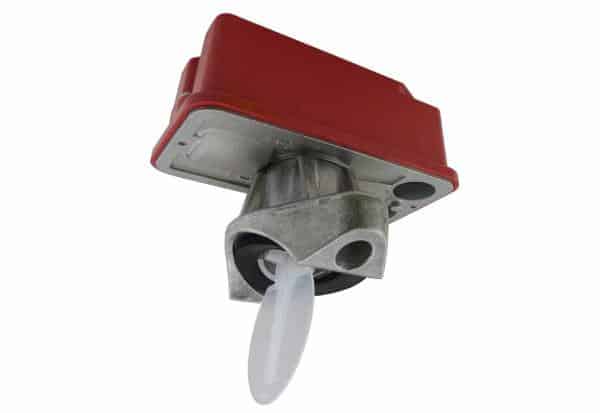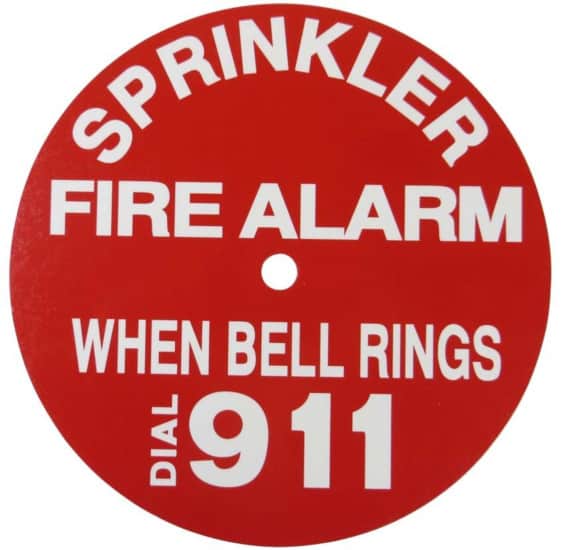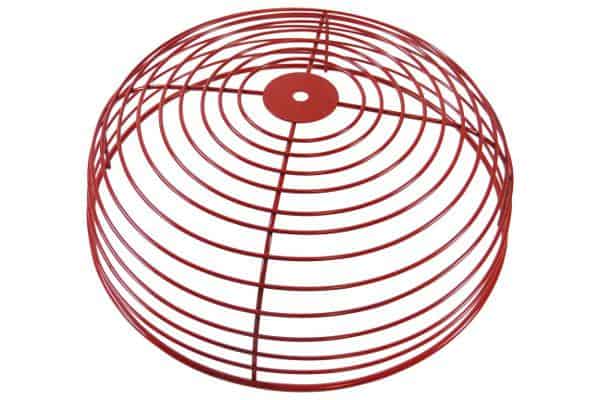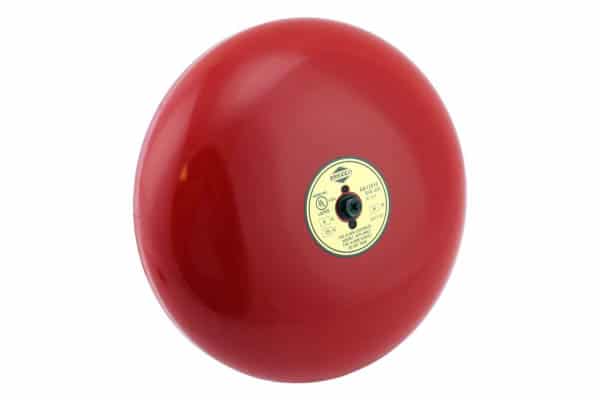Most consumers choose a high-voltage, alternating-current (AC) fire bell—like the 10″, 120-volt model at the top of this page, which works nicely with the electronics (flow or pressure switches) used to sound an alarm. Buy it here.
Is an outdoor bell or alarm required near the FDC that supplements a fire sprinkler system?
Some of the questions we receive at QRFS relate to fire bells and their proximity to fire department connections (FDCs) in a commercial sprinkler system; usually, people ask where an outside fire alarm bell should be mounted, and whether or not one is even required near the FDC.
As with many things in fire protection codes and standards, the short answer is “often, but it depends on the jurisdiction governing the building and the set-up of the fire protection system.” There are some guidelines provided by the National Fire Protection Association (NFPA) and other rules stipulated by the International Building Code (IBC) and International Fire Code (IFC) — which are in turn adopted in enforceable codes by local and state governments.
Read on for the detailed answer. If you need to buy any parts, take a look at our:
- 10″, 120-volt fire bells—the most common choice when installing a waterflow alarm that doesn’t connect to a fire alarm control panel
- 10″, 24-volt fire bells, which have the right listing and voltage for integration with many fire alarm systems
- Water motor gongs that sound a sprinkler or standpipe alarm without electricity
- Back boxes and wire guards to defend outdoor bells against weather, nesting birds, and impact
- Fire department connections and FDC accessories
- Our full line of fire bells and accessories
The purpose of an outdoor fire bell in a fire sprinkler system
This external alarm, sometimes called an “outside ringer,” is connected to a waterflow indicator and intended to notify people outside of the building that the sprinkler system has activated. In the old days, it also importantly served to signal passersby to call emergency services, though system monitoring has often made this obsolete. What it does still do in all cases, however, is let firefighters know the sprinkler is active. And a fire alarm bell can supplement other devices that tell people to get out (or stay out) of the building. And when it’s located near the FDC, it helps direct emergency responders to inlets used to supply a fire sprinkler (or standpipe) system with water.
NFPA requires sprinkler systems of a certain size to have waterflow alarms, which, as the name makes pretty clear, sound an alarm when the sprinkler is activated and water is flowing:
From the 2022 edition of NFPA 13
16.11.2.1 Local Waterflow Alarms. A local waterflow alarm shall be provided on every sprinkler system having more than 20 sprinklers.
7.7.1* Mechanical waterflow alarm devices shall be listed for the service and so constructed and installed that any flow of water from a sprinkler system equal to or greater than that from a single automatic sprinkler of the smallest K-factor installed on the system will result in an audible alarm on the premises within 5 minutes after such flow begins and until such flow stops.
7.7.2* Electrical waterflow alarm devices shall be listed for the service and so constructed and installed that any flow of water from a sprinkler system equal to or greater than that from a single automatic sprinkler of the smallest K-factor installed on the system will result in an audible alarm on the premises within 100 seconds after such flow begins and until such flow stops.
16.11.1.1* An alarm unit shall include a listed mechanical alarm, horn, or siren or a listed electric gong, bell, speaker, horn, or siren.

Does a commercial fire sprinkler system require an outdoor bell or alarm? And does it need to be near the FDC?
Again, the answer is “often, but it depends.” According to NFPA, an outside alarm is not always required in a more comprehensive fire safety system:
From the 2022 edition of NFPA 13
A.16.11.1.1
Audible alarms are normally located on the outside of the building. Listed electric gongs, bells, horns, or sirens inside the building, or a combination of such used inside and outside, are sometimes advisable.
Outside alarms might not be necessary where the sprinkler system is used as part of a central station, auxiliary, remote station, or proprietary signaling fire alarm system, utilizing listed audible inside alarm devices.
NFPA is not the be-all-end-all of fire protection rules, however. The ultimate power lies with state and local government codes and the authorities having jurisdiction (AHJs) who enforce these laws. And the International Code Council’s (ICC) model codes also form the basis of most state and local codes — and most of them embrace some form of the International Building Code (IBC), which requires outdoor alarms with sprinkler systems in new construction.
From the 2021 International Building Code
[F]903.4.2 Alarms.
An approved audible device, located on the exterior of the building in an approved location, shall be connected to each automatic sprinkler system. Such sprinkler waterflow alarm devices shall be activated by water flow equivalent to the flow of a single sprinkler of the smallest orifice size installed in the system. Where a fire alarm system is installed, actuation of the automatic sprinkler system shall actuate the building fire alarm system.
Most states adopt versions of this model code with minor changes and it’s unlikely this sprinkler alarm requirement has been changed. But you can check with your local AHJ to discern whether an external fire alarm bell is absolutely necessary, noting if NFPA 13’s exception applies for sprinkler systems “used as part of a central station, auxiliary, remote station, or proprietary signaling fire alarm system, utilizing listed audible inside alarm devices.” Also, check with the AHJ for what constitutes an “approved location” for the alarm.
That said, there are compelling reasons why an outdoor fire bell is usually near the fire department connection, constituting an “approved location:”
- FDCs must be visible, accessible, and unobstructed. This means they are also a good location for an alarm intended to alert people outside the building.
- The alarm can help guide firefighters to the FDC.
- Practically speaking, by design, both the FDC and the waterflow alarm need to be near the fire sprinkler system riser.
Where should you mount fire bells used as part of a waterflow alarm?
We sometimes get questions along the lines of, “How high should my fire bell be above the FDC?” There really is no specific guidance from NFPA or ICC, other than guidance on how to mount an FDC:
From the 2022 Edition of NFPA 13
16.12* Fire Department Connections.
A.16.12 The fire department connection should be located not less than 18 in. (500 mm) and not more than 4 ft (1.2 m) above the level of the adjacent grade or access level. […]
16.12.1* Unless the requirements of 16.12.2 are met, a fire department connection shall be provided as described in Section 16.12 in accordance with Figure 16.12.1.
A.16.12.1 Fire department connections should be located and arranged so that hose lines can be readily and conveniently attached without interference from nearby objects, including buildings, fences, posts, or other fire department connections. Where a hydrant is not available, other water supply sources such as a natural body of water, a tank, or a reservoir should be utilized. The water authority should be consulted when a nonpotable water supply is proposed as a suction source for the fire department.
To boil this down: make sure FDCs are mounted within the correct height parameters and that they are readily accessible and unobstructed. As long as the alarm bell doesn’t get in the way, it can be placed anywhere near the FDC (usually above it) and should be high enough to carry sound more effectively.
As for the exact location of the FDC, the NFPA 13 Handbook clarifies: “Fire department connections need to be accessible and located where the fire department can use them. Paragraph 8.17.2.4.6 no longer requires the connection to be on the street side of buildings but in a location approved by the local fire department. The language has also been revised to coordinate with NFPA 24.”
Otherwise, NFPA 72: National Fire Alarm and Signaling Code provides mounting guidance for all notification appliances, including external fire alarm bells:
From the 2022 Edition of NFPA 72
18.3.5 Mounting.
18.3.5.1 Appliances shall be supported independently of their attachments to the circuit conductors.
18.3.5.2 Appliances shall be mounted in accordance with the manufacturer’s published instructions.
18.3.6* Connections. Terminals, leads, or addressable communication, that provide for monitoring the integrity of the notification appliance connections shall be provided.
These alarms should also be marked with appropriate signs.

Make sure an external fire sprinkler alarm is listed and protected from the elements
As with most components of a life safety system, outdoor bells and other parts of waterflow alarms must be listed for their intended setting and use:
From the 2022 Edition of NFPA 13
16.11.1.2*Exterior water motor-operated or electrically operated bells shall be weatherproofed and guarded.
A.16.11.1.2 All alarm apparatus should be so located and installed that all parts are accessible for inspection, removal, and repair, and such apparatus should be substantially supported.
A water motor-operated gong bell mechanism should be protected from weather-related elements such as rain, snow, or ice. To the extent practicable, it should also be protected from other influencing factors such as birds or other small animals that might attempt to nest in such a device.
16.11.7.3 Exterior electric alarm devices shall be listed for outdoor use.
NFPA 72 provides additional detail:
From the 2022 Edition of NFPA 72
18.3.3.1 Appliances intended for use in special environments, such as outdoors versus indoors, high or low temperatures, high humidity, dusty conditions, and hazardous locations, or where subject to tampering, shall be listed for the intended application.
18.3.4.1 Appliances subject to mechanical damage shall be suitably protected.
18.3.4.2 If guards, covers, or lenses are employed, they shall be listed for use with the appliance.
18.3.4.3 The effect of guards, covers, or lenses on the appliance’s field performance shall be in accordance with the listing requirements.

Check with your AHJ for specific detail on where and how to mount your fire bell
Local governments rule when it comes to the exact fire code requirements, and authorities having jurisdiction have the ability to evaluate and approve different applications that don’t meet a one-size-fits-all template.
But most codes require outdoor bells signaling fire sprinkler activation in the absence of an integrated, monitored fire alarm system. And even if you happen to be in a location or have a system where an outdoor bell isn’t required, it’s good to have one. It’s also best it is located near an FDC if one is present. This placement is close to where the bell must connect to the riser and ups the odds of the alarm being both heard and seen, and the noise can guide firefighters to the FDC’s location, as well as alert passersby.
Need bells, guards, or FDC components? QRFS has you covered. Check out our inventory of fire alarm bells and accessories and fire department connections and FDC accessories. If you don’t see what you’re looking for, try the search bar at the top of the page, or just contact us and we can likely help you get the part. Call us at +1 (888) 361-6662 or email support@qrfs.com.
This blog was originally posted at QRFS.com/blog on September 18, 2018, and updated on March 24, 2023. If this article helped you, check us out at Facebook.com/QuickResponseFireSupply or on Twitter @QuickResponseFS.



